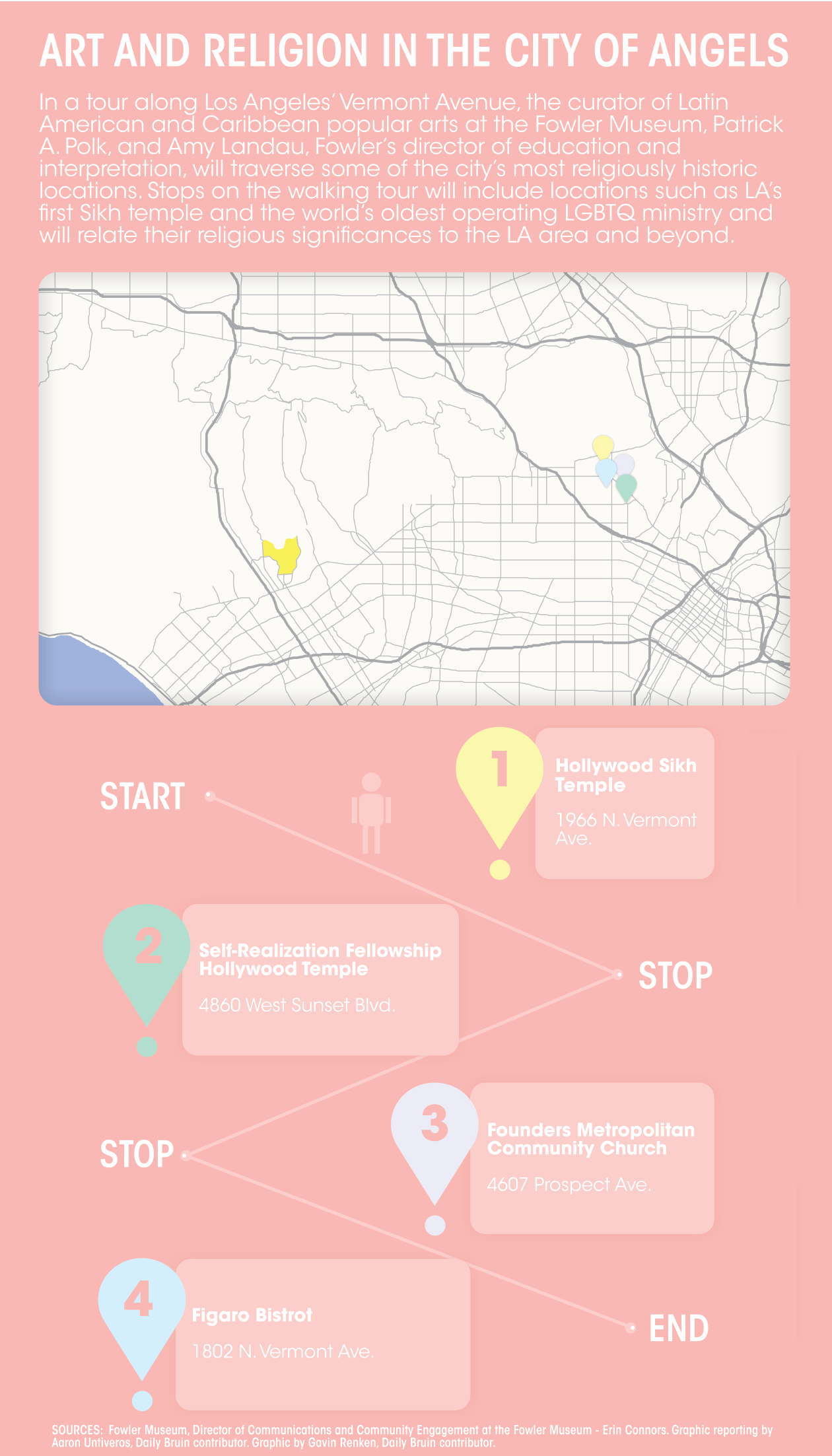Fowler Museum’s walking tour aims to engage community with LA religious sphere

(Gavin Renken/Daily Bruin)
"Art and Religion in the City of Angels"
Saturday, noon
Vermont Avenue near Los Feliz Road
Free
By Aaron Untiveros
March 3, 2020 10:28 p.m.
Take a stroll down Vermont Avenue and encounter the Church of Scientology, the first Sikh temple in Los Angeles and an LGBTQ ministry.
In an effort to spread awareness about religion in Los Angeles, the Fowler Museum’s curator of Latin American and Caribbean popular arts Patrick A. Polk and Director of Education and Interpretation Amy Landau will lead “Art and Religion in the City of Angels.” The three hour walking tour, which encompasses North Vermont Avenue, will be the first of a number of activities the Fowler Museum has planned in order to engage UCLA in the broader religious community, Polk said.
“(Religion) has been a critical issue in the media (and) in scholarship, and folks keep coming back and asking, ‘How relevant is religion in contemporary United States?’” Polk said. “One of our goals is to explore that by connecting as a museum – as part of UCLA – to the community and foster dialogue and connections between these different religious groups.”
[Related: DiverseCity Tours takes students to cultural hubs around Los Angeles]
The walking tour will visit three major religious landmarks, including the Hollywood Sikh Temple, Founders Metropolitan Community Church and the Self-Realization Fellowship Hollywood Temple. However, the tours will also pass by many other religious sites along Vermont Avenue, such as the Church of Scientology.
Because of its diversity and close proximity to each of these important LA religious sites, North Vermont Avenue was a highly desired location for the tour, Polk said. The rich history of each stop reflects not only religion in the city, but in the United States as a whole, said Philip Deslippe, who is one of Polk’s colleagues.
“Not only are (the locations) different from each other, they are diverse enough to point to the diversity of American religion,” Deslippe said. “I think they each say something special in themselves.”
The Self-Realization Fellowship, a temple dedicated to the teachings of Paramahansa Yogananda’s Kriya Yoga dating back to 1920, acts as an example of how much religious history there is in Los Angeles, Deslippe said. Despite many believing yoga was introduced to the city in the 1960s and 1970s, this location proves it has a long history, Deslippe said. Visiting the site will allow participants to see how seemingly recent fads actually have long-running ties to Los Angeles, he said.
Another stop on the tour is the Hollywood Sikh Temple – one of the country’s oldest Sikh sites of worship. The location exemplifies how religion can connect to other spheres in American life, Deslippe said. For instance, he said Amarjit Singh Marwah, a founder of the temple, helped in the election of the first Asian American representative to Congress, showing how religion can also impact the country’s political landscape.
“It is the first Gurudwara to be built after Indian independence in the United States,” Deslippe said. “Not only do I think the Hollywood Gurudwara, like the Self-Realization Fellowship, points to the long and diverse history of religion in LA, I think it is also a site where you can stop and see how influential it has been.”
The tour will also demonstrate how LA is viewed from a global perspective at locations such as the Founders Metropolitan Community Church, Deslippe said. The church was founded in 1968 at a time when LGBTQ rights activists were becoming more vocal, he said. Its early involvement in LGBTQ rights demonstrates the rich diversity of religion and paints the city as a harbinger of progressive social movements, he said.
[Related: Curator discusses historical insights held within Benin bronzes at Fowler Museum]
These three religious sites are only a sample of the institutions the Fowler Museum is working with. The museum has been conducting surveys and mapping religious sites along the entirety of Vermont Avenue – which is approximately 23 miles long – since the start of the initiative, Polk said. Because of the avenue’s distance, at least two more walking tours are in the works to cover different locations, said Bianca Collins, the curator of public programs at the Fowler Museum.
“It’s incredibly important to create links between what’s going on (on) campus, at the museum and what’s going on with programming here at the museum with the city at large,” Collins said. “This tour on Vermont Avenue is just one example of this.”
The museum still has a number of programs and events planned for the rest of the year to engage the UCLA community with the broader religious sphere, Collins said. This initiative works to examine the vast array of religion in Los Angeles, Polk said, and to discuss them in a museum context that is respectful and true to what each one stands for.
“It’s important to develop awareness in the ways different religious groups recognize the sacred and connect or utilize the sacred to create a better world,” Polk said. “Going to the different sites is a way to see the similarities and differences in how people do that with the hope of creating positive change in people’s lives.”


